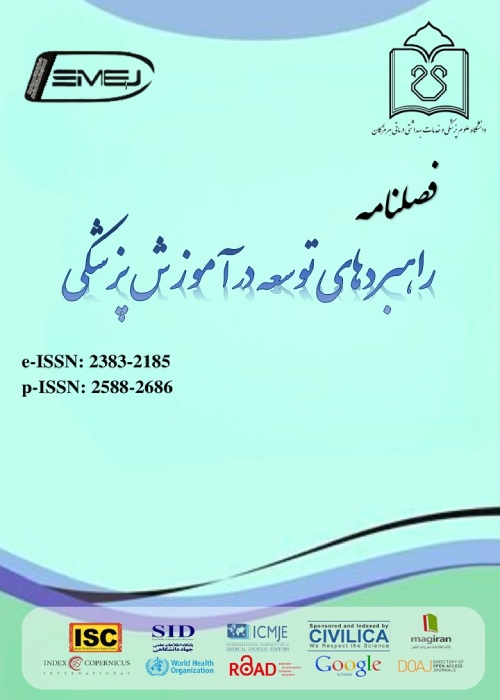The Quantity and Quality of Feedback in Clinical Education from the Viewpoint of Midwifery Students
Author(s):
Abstract:
Introduction
Although feedback is recognized as an integral part of the educational process; it has challenged the educational network complexity from one learning community to another,. Providing training programs to empower teachers and learners in this respect requires identifying educational gaps in the provision of effective feedback. Accordingly, this study is designed and implemented to evaluate quantitative and qualitative feedback in clinical education of students of Islamic Azad University of Kazerun.Methods
This is a descriptive - analytical study that population and sample of which consists of all midwifery students experienced at least one training course of delivery (130). Data were collected by a four-part questionnaire (1- demographic information, 2- closed questions in relation to the time, method, conditions and structure of the received feedback, 3- 16 statements on a four point Likert scale in the study of received qualitative feedback from three aspects of presentation (5 sentences), compliance with educational objectives (5 sentences) and constructive feedback (6 sentences) and 4- an open question: "What factors hinder the use of feedback or has been made ineffective clinical environment feedback in your learning"). one hundred thirty questionnaires were administered to students and 120 completed questionnaires were collected. Data were analyzed using SPSS 19. Descriptive analysis and comparisons of means were used to describe data.Results
In terms of quantity, the results showed that 72.5% of students regularly received feedback and their received feedback during the procedure in the majority of cases (75.83%) included individual (60%), oral (66.81%) and with detailed explanations (7.61%), respectively. In terms of quality, the mean score of students by providing their received feedback and their effectiveness were 2.6±0.5 and 2.7±0.75, respectively, on four point Likert scale. With the exception of six items, most students selected the option of sometimes to respond to quality items. In all three areas of study, students in the third year had a better assessment of their received feedback compared to fourth year students.Conclusion
Feedback is not neglected factor in the process of midwifery education, and even desirable in quantitative terms, but qualitative terms, especially in terms of students in higher education levels, is not offered at optimal level. Although empowerment of teachers can be effective in changing student's opinion about the adequacy of feedback; it is not sufficient. This is because efforts of teachers will be futile as long as students are not capable of receiving and using feedback and do not tend towards it even if trainers to be competent in providing feedback. To achieve effective feedback in the health professions, growing of the receiver of feedback is essential.Keywords:
Language:
Persian
Published:
Development Strategies in Medical Education, Volume:3 Issue: 1, 2016
Pages:
35 to 47
magiran.com/p1595431
دانلود و مطالعه متن این مقاله با یکی از روشهای زیر امکان پذیر است:
اشتراک شخصی
با عضویت و پرداخت آنلاین حق اشتراک یکساله به مبلغ 1,390,000ريال میتوانید 70 عنوان مطلب دانلود کنید!
اشتراک سازمانی
به کتابخانه دانشگاه یا محل کار خود پیشنهاد کنید تا اشتراک سازمانی این پایگاه را برای دسترسی نامحدود همه کاربران به متن مطالب تهیه نمایند!
توجه!
- حق عضویت دریافتی صرف حمایت از نشریات عضو و نگهداری، تکمیل و توسعه مگیران میشود.
- پرداخت حق اشتراک و دانلود مقالات اجازه بازنشر آن در سایر رسانههای چاپی و دیجیتال را به کاربر نمیدهد.
In order to view content subscription is required
Personal subscription
Subscribe magiran.com for 70 € euros via PayPal and download 70 articles during a year.
Organization subscription
Please contact us to subscribe your university or library for unlimited access!


